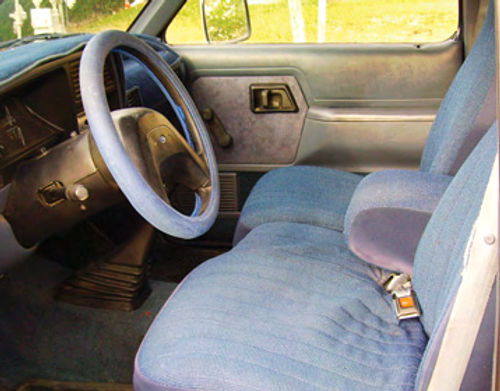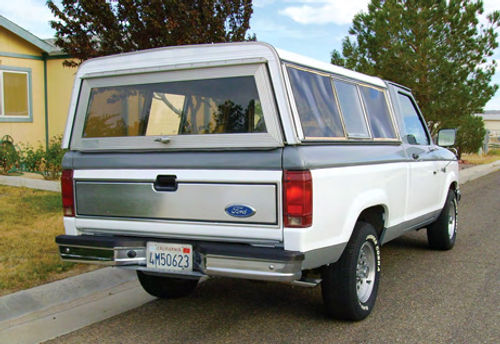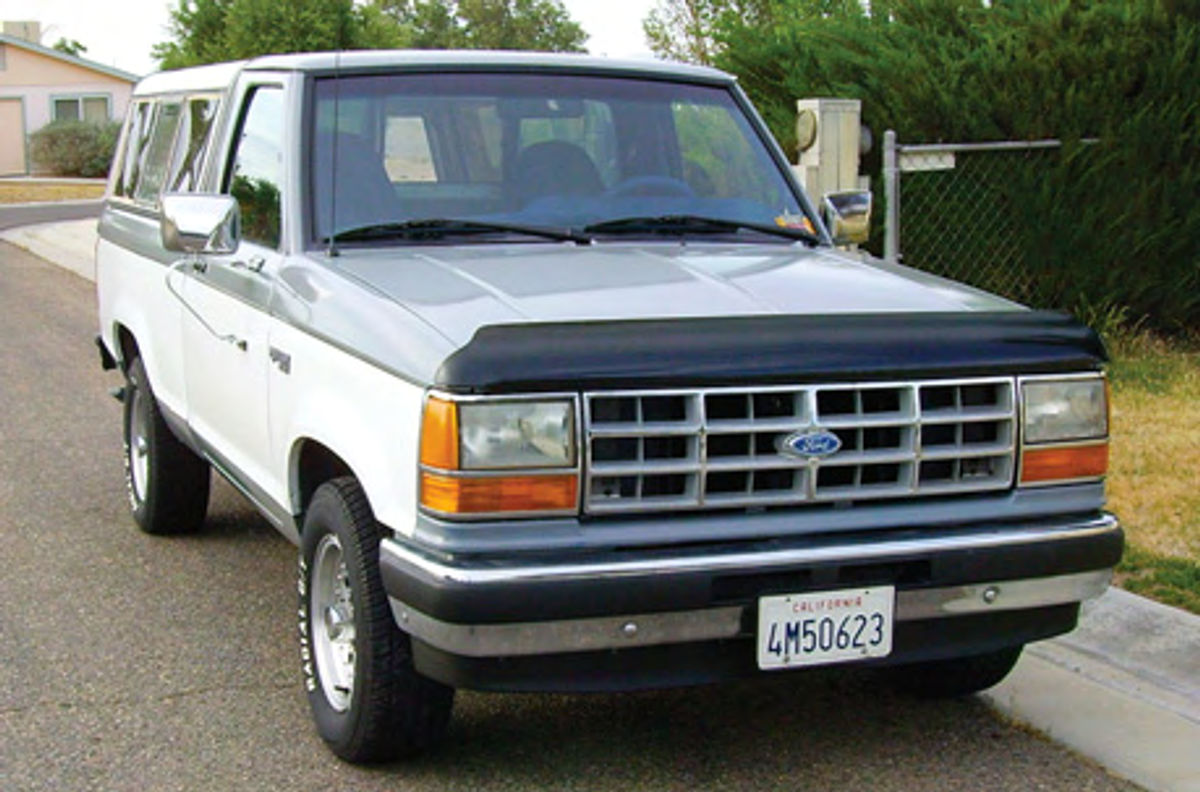A Restorer’s Story 1992 Ford Ranger XLT Pickup
He Bought It New and Is Hanging Onto It.
I ’M NOT SURE when the compact trucks took off in popularity, other than it wasn’t with the 1939 Bantam pickup nor was it with the 1949 Crosley. I think it was with the Japanese imports in the early 1970s; particularly in 1973 when in some areas of the country gasoline was being doled out in 5- or 6-gallon allotments.
When I was in the Navy my first supervisor had a 1973 Datsun with a Perris cab over camper. It was quite the rig and it did feel very stable while driving although it looked top heavy.
Everyone was selling the small Japanese trucks during the ’70s. Chevy had the Isuzu-built LUV, Dodge had the Mitsubishi-built D-50 and Ford had the Mazda-built Courier.
But Ford wanted a home-built small truck, so during 1982 the compact Ranger came on the market as a 1983 model using the Ford Twin I-Beam front suspension that had first appeared on the F-100 in 1962. Ford came out of the gate with both a short- and long-bed standard cab in 1982 then later added an extended cab, 4x4 and various I-4 and V-6 engines. Additionally, in 1983 the 2.2-liter Perkins Diesel I-4 engine was offered. In 1985, the 2.3-liter Mitsubishi I4 turbo diesel was available. (I drove a Mitsubishi turbo diesel truck back in 1987 while in the Philippines and it was quite powerful so I’m sure the Ranger with that engine would be a nice drive.) In 1998, Ford replaced the Twin I-Beam front suspension with the more common upper and lower control arm suspension.
But the market for compact trucks shrank in recent years as people turned to small SUVs or medium- to full-size trucks with improved fuel economy, and at one point Ford planned to discontinue the Ranger in 2009 but then extended the line to 2011.
Earlier this year Ford introduced a redesigned 2012 Ranger in Australia and said it would be sold in 180 markets worldwide…but not in the U.S.
The Ranger was the only true compact truck left for sale in this country and with its removal from Ford’s domestic offerings, that segment will disappear from the new-vehicle market.
In other words, if you’re interested in a compact truck for your garage, you’ll have to consider a recent used model or a vintage hauler.

Now, About My Ranger…
Like my 1982 Mercury Cougar GS Station Wagon that was in the June 2010 issue of Auto Restorer, my 1992 Ranger XLT standard cab short wheelbase truck has been undergoing a “rolling” restoration for the last five years. I searched for the right truck for months more than 19 years ago. I bought it new on April 24, 1992 and thought that I’d drive it for 10 years or so.
Ultimately, it made no sense to get rid of a low-mileage truck and it currently has 110,000 miles. It has been recalled once for master cylinder mounting studs that would corrode in 10 southern California counties and has had no warranty repairs except for the paint.
It’s been so reliable only normal maintenance of wear items has been necessary; there is no valid economical or mechanical reason to replace it.
Living in California’s desert there is no rust to worry about. (On the other hand, I’ve heard that the compact Rangers can rust all the way back to nature leaving only a pile of glass and rubber behind in the salt-spreading states.)
Millions have been produced since 1983, and 1992 production was over 490,000 units, Ford’s best year for the compact Ranger.


My truck came with the XLT package, air conditioning, stereo cassette, power steering, power brakes,larger 21570R14 tires on 10-hole aluminum rims, a 60/40 split bench seat, a sliding rear window and midnight blue metallic paint. I bought the bed topper from the same dealer where I got my truck. It came from another Ranger that had been traded in.
Time for Some Updates
About five years ago, my truck started needing some non-scheduled maintenance. The air conditioning compressor seized and that was a good opportunity to repair and convert to the 134a coolant. I had the system evacuated so as to not vent the R12 coolant to the atmosphere which is a no-no everywhere. Since there was plenty of under hood space, the project was quite simple. I purchased the plastic a/c coupler tools then I removed the broken compressor and the receiver/dryer and flushed out all the old oil from the rest of the system. I also replaced all the black O-rings with the 134a-compliant green ones. I also installed a 134a compliant metering orifice along with the new compressor and receiver/dryer. Finding a vacuum pump was an issue but I found one to borrow along with the gauge set. I filled the system with the 134a and all has been well for the last five years. The cost was $312 total and my labor was free.
I loaned my truck to my son for an extended period about 10 years ago and received an unexpected benefit in return. The Ford radio had failed while my son was using the Ranger and it came home with four new speakers and a Sony AM/FM stereo with a CD player.
Buy a New, Not a Rebuilt, Pump
Just two weeks later the power steering pump was howling so I purchased a rebuilt unit and borrowed the pulley removal tool from the auto parts store. I flushed the power steering system with clean transmission fluid as Ford recommends.
Unfortunately, I had to do the job all over again last year, this time with a new pump. I’ve found that it’s common for Ford pumps to get noisy,so it’s my recommendation to only work with new ones.
Other mechanical repairs included a new thermostat housing that was leaking. That was when my son was using the truck and a Ford dealer in Bakersfield,California, also replaced the timing belt and water pump at 71,000 miles.
With the I-4 engines it’s a good idea to replace the water pump when the timing belt is changed. It’s one of those while you’re-in-there items. Murphy’s Law says that if you don’t, you will a week later and incur additional labor charges. I think this job will be due again soon but so far there are no cracks or wear on the timing belt.
Of special interest is the fact that on Ford’s Lima 2.3-liter I-4 it is more of an inconvenience if the timing belt breaks as you’re dealing with a “non-interference” engine meaning that if it does fail the pistons will not impact the valves.
At 95,000 milesthe clutch slave cylinder was leaking internally resulting in difficult 1st and reverse engagement and required the removal of the transmission to replace it. Again, while I was in there I replaced the clutch and pressure plate even though there was little wear on the clutch. There was no need to refinish the flywheel as the clutch had hardly worn at all and there were no scratches or glazing on the flywheel surface.
The transmission and bellhousing is all one piece so it was quite heavy even though it is the aluminum-case Mazda M50D-R1 five-speed. I used a motorcycle jack to lower and reinstall the transmission. The most difficult part of the job was removing the upper right bell housing bolt. It was over-torqued and I spent the better part of five hours removing that one bolt. It took four hours to break it free, followed by an hour making 1/16th of a turn over and over with a 13mm open end wrench. Ironically, getting at the bolt wasn’t the problem. The trouble was in gaining leverage without busting my knuckles.
Bleeding of the hydraulic clutch also was a one-person job. It bleeds much like the brakes and I was able to do the job myself using a 2x4 to hold the clutch pedal to the floor then open the bleeder. I only had to repeat that process four times and it was complete. The clutch has been trouble-free for the last two and a half years. This transmission has been used since the early days of the Ranger and has been revised to an M50D-R1HD, the HD indicating heavy duty.
There was a problem with fluid leaking from the transmission early last year. There are three shift rail plugs up high on the transmission behind the shift mechanism. The plugs are rubber and had shrunk over the years and were loose. I removed them and coated them with red Permatex gasket sealer,reinstalled them and haven’t had any more leakage. The transmission uses automatic transmission oil so I imagine it splashes around while driving; otherwise I don’t think those plugs would have leaked.
Time for an Inside Job
Inside my Ranger the seat finally wore out after 15 years so I purchased a cover from dashdesigns.com. They make a good-quality cover I chose the dark blue tweed that went with the rest of the interior. It also matches the dash cover I bought years ago from the same company. The materials do not fade, a definite plus in California’s high desert, and a side benefit is that the dash cover has protected the dash from cracks.
I’ve always used floor mats so the carpet is like new as well. I do use a steering wheel cover because the black steering wheel can get quite hot in the sun. It also gets dirty and gummy like the many steering wheels mentioned in letters to this magazine over the last few years.
A Troublesome Fuel Filler Pipe
There is one critical area of concern that needs to be watched by everyone with a Ranger—the fuel filler pipe can crack at the fuel tank connection allowing fuel to spill. This also will cause your truck to fail the emissions test in states like California that measure evaporative emissions levels.
I replaced mine four years ago with the Ford replacement part that cost $254. Now they can be found quite readily on eBay and from parts suppliers on the Internet. LMC Truck, for example, has replacements available online. In addition to Ford, they carry partsfor GM and Dodge trucks as well.
To change the assembly I found that removing the bed of the truck was much easier than removing the fuel tank as the Haynes manual suggested. Two electrical plugs for the rear lights, three bolts on the fill tube flange and six bed bolts made the job simple. There is not enough clearance to leave everything in place and still access the clamp at the tank.
Reaching for a Paint Roller
The Ranger’s paint was quite bad compared to the general condition of the rest of the truck. In fact, before the truck was two years old the paint on the hood peeled off in one big sheet. Ford paid for the repaint and then, a year later,the roof peeled. Again, Ford paid for the repaint. Then, when the truck was 12 years old, both sides of the bed peeled and the clear coat on the roof and hood was failing. Inspecting the primer that was left clearly indicated why. The primer was as smooth as glass. I’ve found that many vehicles manufactured during the late ’80s to mid-’90s peeled in this way. There must have been some change in processes during those years.
Rather than pay for an expensive repaint I decided to repaint it myself using the oft-written-about-on-the-Internet $50 paint job. I’d been seeing those paint jobs on the Internet for upward of seven years and thought, why not.
I sanded down the whole body, repaired some parking lot dings, primed the bare spots and body filler and went to it with a roller. I’ll not repeat the process here as it is well-covered on the Internet. The short story is two coats then wet sand with 600-grit, two more coats and wet sand with 800-grit, two more coats and wet sand with 1500-grit and, finally, two more coats, wet sand with 2000-grit and polish.
I skipped the last two coats as I had great coverage but I did the 2000-grit wet sand and polish. I was pleasantly surprised at how well the wet sanding went and how few sheets of paper were required. I’m not so sure (Auto Restorer contributor and restoration pro) Larry Lyles would approve as he does beautiful work but the paint fully accomplished what I desired; glossy and smooth paint in a two-tone configuration that is simply repaired when necessary using simple materials and tools.
Furthermore, the neighbors never noticed that I was painting; there were no strong odors or over spray to foul the neighborhood. No extreme safety precautions were necessary nor was a paint booth required.

I used Rust-Oleum Enamel Gray#7786 and white #7792 both in quart cans (two of each) thinned 1:1 with mineral spirits. A 1:1 ratio results in one full gallon of each. I also purchased the #7786 and #7792 in aerosol to spray the hard-to-roll areas such as door jambs and tailgate sides. I ended up with one quart of each color left over for repairs.
The bad part of this process, of course, is lots and lots of hard labor. To me the most difficult part was the taping, un-taping, re-taping, over and over again. But it must be done that way because if the tape is left on with all those coats of paint it will not come off once the paint is dry.
As the story goes, the paint will not fade and requires only normal cleaning along with waxing a couple of times a year. We’ll see on that although I’ve come across some photos claiming to be evidence that the paint does last.
Since I needed everything: rollers, tape, paint, foam brushes, mineral spirits (1 gallon), pans, rags and pinstripes, the total cost to me at Wal-Mart was $170. I think it was named the $50 paint job because the paint and mineral spirits still only cost a few cents more than $46. I already had polish and a buffer. I used a wool pad on the buffer to do the polishing after the final wet sanding.
There will always be maintenance to do but I now feel that my truck’s restoration is complete. The way I see it, my Ranger should easily provide another 19 years of service.
















